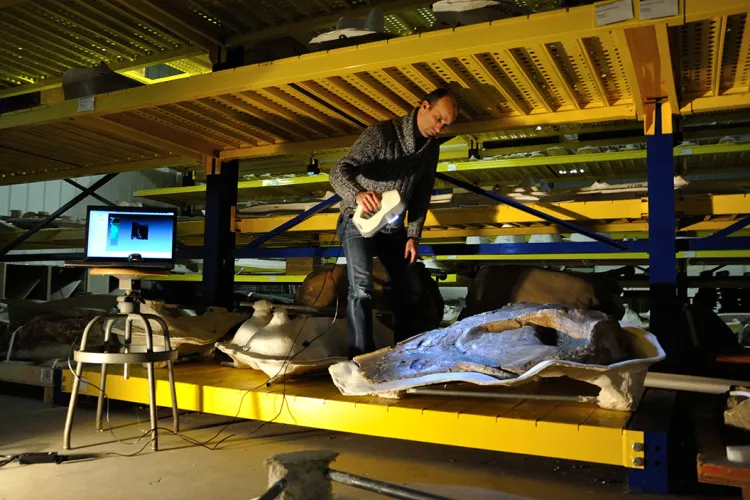Biologist Matt Leslie Renames Extinct Whale Species

When Leslie and his co-authors began analyzing the skull of the Norrisanima, it became clear the specimen didn’t have any of the characteristics of the modern humpback whale. Photo by Nick Pyenson, Smithsonian National Museum of Natural History
A research team led by Visiting Assistant Professor of Biology Matt Leslie recently redescribed and renamed an extinct whale species, capping a journey of personal and professional resonance for Leslie.
The newly described Norrisanima miocaena was first noted in the early 1920s and thought to be an ancient relative of the modern humpback whale, within the genus Megaptera. But in their research, published earlier this month in the scientific journal PeerJ, Leslie and his co-authors show that Norrisanima came from a group of ancient baleen whales that branched away from those we know today.
Thanks to advances in evolutionary understanding over the past 100 years, the research team—which also included Carlos Mauricio Peredo, paleontologist at the University of Michigan, and Nicholas D. Pyenson, curator of fossil marine mammals at the Smithsonian Institution's National Museum of Natural History—knew that the link between Norrisanima and the modern humpback whale didn’t hold water.
“We had to do something about it,” says Leslie. “We couldn’t just let one of the most important pieces of evidence for the recent evolutionary history of whales just sit around with a lackluster description and misleading name.”
The team reanalyzed the original fossils—collected near Santa Barbara, Calif.—and compiled evidence. As they started analyzing the skull of the Norrisanima, it became clear the specimen didn’t have any of the characteristics of the modern humpback whale.
“So we had to broaden our search,” says Leslie. “Could this be something else?”
The team ultimately compared this whale to modern and fossil whales, finding that it didn’t quite fit with those, either, and needed its own classification.
“I was amazed at the quality of the specimen—a rock over 70 million years old” says Leslie, who tweeted a three-dimensional rendering of Norrisanima. “Its size, too: The skull weighs over 450 pounds and is the size of a dinner table.”
Leslie took something of a jagged line to the project, drifting from traditional zoology in favor of genetics and genomics in grad school. But in 2017, he earned a Secretary’s Distinguished Research Fellowship at the Smithsonian’s National Museum of Natural History—one of whose researchers was the first to describe Norrisanima almost 100 years ago—and began a project on large-scale evolutionary genomics of baleen whales.
“I was really excited about working at the Smithsonian, getting back into comparative anatomy using museum specimens,” says Leslie, whose sponsors on the fellowship included Pyenson.
“I expressed my interest in learning from the specimens that surrounded me at the museum, and we were off,” says Leslie. “But we knew this particular specimen needed some work, and that it was a big commitment to sort out the anatomy and nomenclature.”
In renaming the whale, the researchers honored the late Kenneth S. Norris and his son, Richard D. Norris, for their contributions to natural history, marine mammalogy, evolutionary biology, and paleontology in California. They also note the Norrises’ teaching and mentorship legacies at establishments like the Scripps Institution of Oceanography, where Richard Norris served on Leslie’s doctoral dissertation committee.
“The Norrises were and are really committed to passionate and immersive teaching of natural history and conservation biology,” says Leslie. “Their approach was to take students outside to show them the natural history, to let them experience it all through their senses.
“Moreover, the Norrises exhibit childlike exuberance and curiosity that are hard to find today in academics,” he adds. “They really wear their excitement and respect for the natural world on their sleeves, and it’s infectious. I try to model this in my own teaching.”



